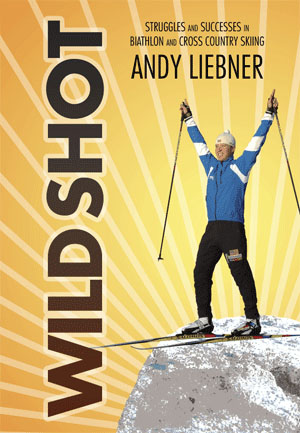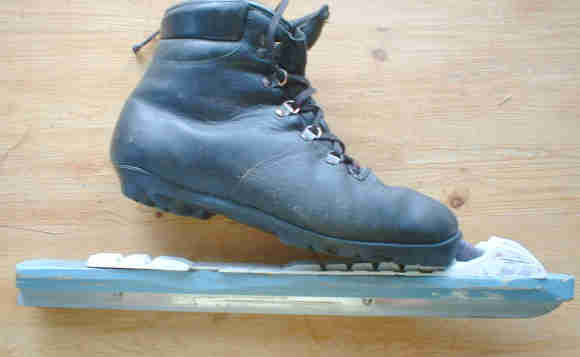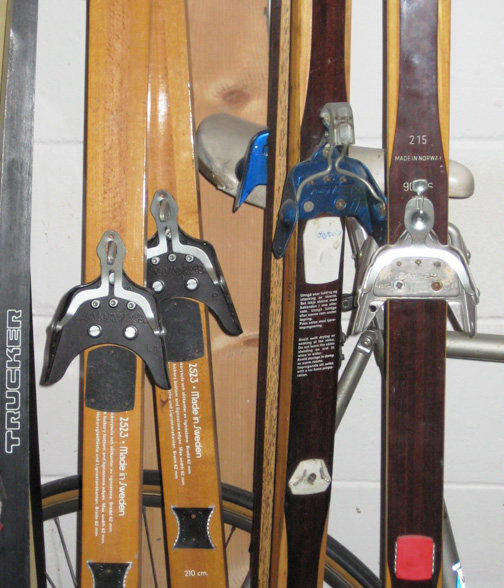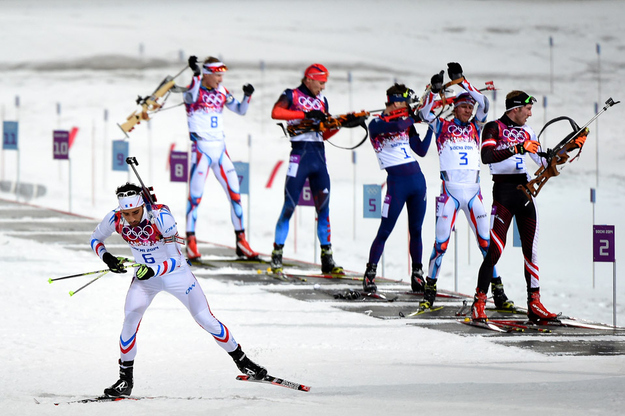[Revised yet again 2/2. Bike specific content removed. Bike-XC essay now at AllBikeMag.com only.]
Here’s the situation. The mid-Michigan area I live in is full of woodsy trails.
Come winter the dozens of trails in our area get all snowy—so do our frozen rivers, lakes, woods, fields and golf courses of all kinds (some quite hilly and woodsy). So I do what seems obvious: I stop riding my bike as often and instead go XC skiing at these places almost every day all winter. Each week I hit as many places as I can, but the ones near my house are nice enough. Sure, some weeks we don’t have snow—we’re in a middling snowbelt—but mostly anywhere there’s a little snow there’s decent XC ski conditions.
…And “decent XC conditions” means a GREAT TIME is ready to be had!
Of course, where it’s too slushy, everything is miserable, and everyone stays home. But where I live we get 50-100 skiable days and, say, 150 good days or so only an hour or two north.
You’d think the bleakness of our local winters might actually get more people outside than in sunny snow places because we need it more.
On the roads and in the towns it’s often butt-ugly in winter: slushy, gray, overcast, dirty, dirty, dirty.
Out in the woods it’s the cleanest time of year! White white white! Fresh fresh fresh! Air, water, everything.
Winter slows folks down, but it shouldn’t keep them away from where the action is just right and where cold isn’t cold anymore. What’s more is that I notice people saying they can’t afford skis. Well, people who spend $100 at the ballpark shouldn’t complain that a $300 complete XC ski package is too much. It’s time for an attitude adjustment!
Let’s make sure we understand XC…
All-Body Scenic Dyno Action Sport!
Coach Anikin said it best: we like skiing because of GLIDE.
But there’s more to it. Glide gets us in the door. Let’s see how the details sort out…
For instance, it can be helpful to think of XC skiing as being like biking only without the moving parts. And without the danger. In XC you can go anywhere, even on water (ice). Trails are cool but skiing is bigger yet: you can bust off and go right thru the woods—especially on crust snow—or cover the fields like a deer.
People around the Midwest should realize that we only have moderate alpine skiing hills. They’re pricey and often hours away. But we have thrifty WORLD CLASS XC ski trails and skiable terrain almost everywhere. The same must hold true for everywhere that has snow and mellow terrain.
Skiing is also great in that you get to love the hills. That’s the amazing thing about XC compared to other skisport: when you do it right you get sweet glide going UP the hills. In fact, I think uphill glide is sweeter than the obviousness of descending. Who cares if it’s a bit slower. The miracle is bigger. When you’re dialed in for climbing, you just float up, like you’re getting more back than you put in. The speed, action and intensity is about the same going downhill in all the glide-or-roll-sports, but with XC you’re more exposed uphill and down. (The exposure for a biker on a fast downhill is more dangerous. But his position is more closed-up in contrast to the open dyno moves a skier makes when taking wild corners on a descent.)
In terms of raw speed, didja know that the Chequemegon mt-bike race is won in about the same pace as the Birkie ski race which is held on basically the same trails? And people always consider lift-served skiing to be fast but one is rarely going faster than 20mph on a challenging run: you often go faster on XC descents.
Now, mt-biking has its famous singletrack jones, but XC has it, too. It’s just not covered so much in the media or at official XC resorts. XC actually beats out mt-bike here: to thread a narrow course need you can pivot on a heel on a ski rather than have to guide a whole bike wheelbase. So where do you find tasty XC singletrack? Just hit your fave bike singletrack when the snow flies! It’s not likely to be groomed, so just ski it in yourself and use touring skis. Groomed ski trails are usually too wide to give the singletrack dyno thrill. But there are a few narrow or at least wild’n’twisty groomed trails out there. You can also easily make your own—just find a way thru the snowy woods and ski it in a few times. Instant trail! No enviro impact. Gone with the snow. (Bill Koch recently complained in a ski mag interview that handling skills aren’t pushed as much these days in XC. I agree. Before litigation really sunk in, at about 1983, an expert-level groomed trail could be wild indeed. These trails have been greatly smoothed out since then, taking away the challenge. You have to make your own to get more.)
To look at handling skills further, with XC you’re using the whole body and get a sense of full abandonment style as you throw yourself into the moves. You blast corners, catch air, your body parts tossed every which way by G-forces. You’re chest-first to the elements, flying down the hills, twisting the chutes, upright and exposed.
XC offers range of action to beat the band. It’s expressive, in a way. You throw your body forward, down the trail, then reach out and catch yourself, throwing yourself onto the poles, kicking as far forward and back or to the sides as your legs will go—everything on your bod is swinging and flinging far and wide. You “pop” your core then let your limbs, fly out, relaxed, to the end of their stroke. Yet it’s low impact. It offers explosiveness without strain. Cool!
XC is like dancing. Classic and skating each offer several distinct moves or techniques for any situation. Keeping your Big Mo flowing best through a course involves seamlessly changing up between all these techniques, sometimes using a different move on each stroke, all in rhythm. In fact, in other languages the skating moves are called “dance,” as in “paddle dance” and “double dance.” XC is a big beat!
XC is unique in its all-body terrain action. Well, slide-seat rowing is similar but there’s not much topography. Water is cool and waves are lovely, don’t get me wrong. The kind of rowing that’s something like skiing is the ultralight superthin carbon boat kind, where the hull is no wider than your hips and disappears under you. That kind gives you a flying sensation somewhat similar to skiing—but slower and without as much dyno terrain action, except in big waves. (Rowing is bigger on swinging rhythm, though.)
The special thing about XC is its “gathering-bursting” style. Rowing has some of this, in one plane. Inlining and running have much less. XC is a continuous leaping. You know the explosive feeling you get from a great run-up then dive off a springboard into water? Or the rhythmic gathering of the butterfly stroke? XC is like both of those ALL the time. Each stride is a punchy leap yet it’s smooth. It’s a leap into thin air. Total body toss. XC has what’s called “hang-time,” a thrown-abandon between efforts where you glide, float, fly and relax. In skate I call it the “angel hang.” You throw yourself, pop your move, arms are flung behind you, and one leg pops out to the side and is floating there a moment. You’re rocketing along at, say, 15mph on one foot, chin out. Pretty cool.
But back to equipment. This can be a cosmic aspect of skiing: the “no moving parts” thing. That’s cool. OK, there’s one moving part, the binding, a minor thing really (iceskates are cool because they don’t even have that). So here’s a ski, with a flat bottom, and it glides like a skate with a razor edge. That’s cool. Then there’s wax: in classic you have kickwax which when buffed isn’t hardly visible: yet it GRIPS. And when pushed it GLIDES! Grip and glide, all on one smooth, flat ski. Kinda neat. A biker can appreciate the simple elegance of it, I think—especially a fixie rider, right?
Skisport, cycling, ice-skating and inlining all play off glide (or roll), making them close cousins. Worldwide, in snowy areas you find lots of crossover between top athletes in these sports. They belong together. Do one, do them all.
All-Body Dyno Scenery!
In the winter, with no leaves on trees, trail vistas are opened WIDE. Summer has a close-in jungle feel. It’s cool in its own way, of course, but there’s sweat, bugs, prickers, and nettles. Winter offers glide glide glide. And the AIR is so CLEAN! No pollen, no cloggy humidity.
Ski trails are where many sports meet. Maybe a quarter of the skiers out there are mainly skiers—most of them do other sports more often. It’s really not snowy that much of the year around here, after all. The ski trails are the one place where bike racers meet canoe racers—runners and triathletes show up, too. Hikers and bike tourists probably probably comprise the skiers who have the most fun—they’re out with bread, cheese and winesacks and who look for interesting trails and sights and who cares about the workout. But everyone has a great time in their own way.
In winter the hillier golf courses offer a treat that you can’t get on them in summer. And they really come on strong when it gets crusty—what fun it is to bomb their tidy rolling hills. (Stay off the greens and there’s no harm. I’ve never been hassled on them.)
XC has another fresh angle: frozen waterways. A couple weeks a year around here the snow and ice are just right for skiing the woodsy lakes and open cattail swamps. Sometimes I can even add in our twisty rivers. It’s a wide-open blast.
Then comes another joy: crust skiing! Springtime brings sunny melts and refreezes, for skiing or skating anywhere in the woods, dodging trees, flying over the lakes, leaping the fields, having a blast. It’s total liberation from the limits of trails. It’s a time of sunshine, suntans, wineskins, picnics—shorts and shortsleeves even.
Now, alpine, telemark and snowboarding are fine—where you can find em. But you need more snow and more terrain. Probably only 10% of snowcountry is truly hilly enough for downhill action. With XC all you need is gravity and a couple inches of snow, toss in a little hill and you’re set for fun. Of course, grooming for XC can get as sweet as any snowsport, but it’s optional. And steenking chair-lifts don’t even apply. XC is a “wherever you are” sport rather than a resort sport, and even at resorts XC is tons cheaper and has far less enviro-impact. Now, XC is thought of as hard work. Well, you work just as hard doing alpine dyno-style. And compared to lift-resorts XC trails go places. Some alpine runs have heritage, but, truly, trails trump runs.
Then there’s the hang-out factor. There are no helmets and not that many sunglasses or fancy outfits. There are lots more snacks and more wineskins. The winter woods is a quiet, intimate setting to hang out in with your pals. Skiing is a way to get the woodsy hang-out vibe that mt-bikers enjoy all summer. I’ve heard roadies say that they see their road-pals more often on the ski trail and in the ski-trail parking lot in winter than they see each other out on the road in the summer. Trails bring folks together.
It’s known that woods and mt-bike trails are cool in summer—compared to the parching heat of pavement. But it’s less known that woods are warm in winter. No need to expose yourself to the artic blasts. Hide out in the dyno woods.
Sometimes I see the futile, lame, ugly marks of a biker trying to ride a ski trail. He doesn’t get far. It hurts the ski trail. It’s not done much. Still, the trails are right there, a few inches down, calling you. So I can understand the urge. But do the right thing AND USE BOARDS!
All-Body Dyno Technical!
If you still have a cost nag, c’mon, my $300 set-up has lasted me 15 years. I keep adding more skis, though. I got no-wax skis at the thriftshop for $20 to go with my waxables. I have skaters, too. Heck, I have big ole cheap wood snowshoes for the WAY deep stuff (that float is SO cool). I’m totally covered. It can be cheap compared to other sport stuff. Don’t forget that skis can last, last, last.
It may be that due to the heavy marketing of race-style ski stuff that some versatility has been lost or that people think that only groomed areas are good enough, even if they need to drive hours to get to them. This ends up hurting the ski scene. Groomed skiing is great, no doubt. But so is every other kind. It’s good to enjoy versatility in XC. All it takes is a ski that’s a bit wider than a groomed-track ski and you can get great glide anywhere. A track ski tends to be under 50mm wide. An all-terrain ski of 55-65mm gives you great float and glide in ungroomed snow. A 55mm ski still works fine in groomed trails AND gives float for bushwackin’. That’s the ski I use most every day. It’s a strong ski, too. I’ve done plenty of jumps on mine. But then I don’t live near groomed trails. If I did, I’d use what works best there. Just remember that as long as there’s snow, XC offers a mode that works GREAT.
Even when the snow is gone you can still get most of the fun on rollerskis. It’s not the same but it’s still all-body action. With fast wheels you can even go places.
And lore? You want lore? Skiing is full of it. It’s all about great adventures and wacky mishaps and trails but it’s also about everyday technique and waxing. It’s endless if you want it to be. Or you can revel in the simple and tried’n’true.
Maybe some folks shy from XC because it seems like figure skating: too hard to do. Well, a couple lessons from either pros or buddies and you’re in like Flynn. After you start you can improve for the next 10 years straight if you like.
One can enjoy just slapping on whatever wax works and have fun with that. Or one can test waxes, base-rilling and brushing and find combinations (sometimes with cheap old waxes) that are lightning fast. Wax em up in 10 minutes and away you go—you might easily know which wax will give you rocketships. If you try them out and think you can do better and have time, you can be back on the trail and try again in short order. Waxes smell good when ironing and once you get a feel for your trails and snow you’ll never feel a fresh snowfall come down again the same way: Oooh, it’s Swix Purple, oh yes! Dang, it’s going to be Rex Blue all the way tomorrow, for sure! Oh man, it’s getting cold—but not too—Extra Blue will rule! Hooo, it’s cold—better get that Start Green buffed.
As far as technique goes, ski with better skiers and imitate them. Ski and ski more. Try to get more glide with less effort. How to get max kick with least raising and lowering of body mass? Feel the sweet spot, just flow up that hill—kick off the heel, complete the poling, extend that glide. Oh yeah! Initiate that doublepole with a pop. Fall on those poles. Swing that foot forward. It’s a world of a half dozen techniques (for each major discipline, classic and skate) that combine with infinite variety.
Skiing isn’t a town-to-town or destination thing so much. It’s a motion jones. Scenery is important and trails are a major thing. But it doesn’t take much to keep a skier happy. That’s coz the action itself is so sweet. I’ve been doing it for decades and I still enjoy the float, hang, glide, and getting the most out of the rhythm: flow, flow, flow. —Just on my mile of neighborhood trail.
All-Body Dyno Skills!
Sport skiing with pals goes a lot like riding in a bike pack. If you ski close together you get a draft. The faster you’re going, the more important the draft is. When you’re in a race, or at race-pace, then you’re talking full-on tight clusters of dueling skiers. Those looking to win are jostling for position, waiting to make their moves. The climbers attack the hills. The handlers wait for the twisty downs to jump out and take off. Sprinters mooch til the last few meters. As I’ve mentioned, the speeds are even similar. Ski skills cross over to cycling skills, baby!
Then there’s the workout. XC makes every part of you strong, flexible and longlasting. You get a huge range of motion workout but with most of the work coming from your core. A skier moves around so dyno on the trail that when weird things happen, like crashes, they’re less apt to get hurt or strained. They’re resilient. In XC you work your V02Max to the max. After a winter of skiing, you can bust into a huge Spring of any other sport.
I like how the Europeans ski. It’s like how they ride bikes. They ride elbow to elbow, bumping around without a thought, leaning on each other to tell stories. When skiing they bunch together so they can chat—you’re tip to tail or if ski-skating your skis are meshed in with theirs, with your tips gliding up between their tails and your pole plants coming close to theirs. Yet they’re relaxed. That’s the secret. Relax, have fun, ski together, why not. Younger skiers of this style will clown around and do tricks willynilly as they ski. They might do a forward roll off a bank into deep snow or kick together a little jump on a downhill and go up and down a few times jumping and catching yards of air, landing in their best telemark. Then they continue on their way.
As a sidenote, it might be that classic skiing actually boosts fitness more than the skating style. Top ski racers train more than half classic even if they’re skate specialists. Skating is developing a higher turnover these days and its poles are getting shorter but it still has a longer power-phase and slower tempo. Classic somehow lets you get more power into each stroke. Because the skate stroke is long it can’t be so hard—a hard shove can make a ski wash out. Classic lets you put total effort into each fast kick. Don’t forget classic if you really want a hone. Especially at high altitude.
And did you know that basically classic and skating are the same? All the same angles and weight transfer skills are involved. Body position is the same, even equipment is starting to become more alike. So if you learn one, you got em both. Heck, a dyno-ready body position does the trick for all snowsport—maybe for all sport, huh?
Then there’s ski racing. Every weekend in winter snowcountry there’s a Sat and a Sun XC ski race near you. They’re each like a winter festival. People are cheery, the colors are bright, the snow is white. People are at least as friendly as at summer races—the cold might bring out more neighborliness. Entry fees are on par with other races. Or try a midweek time trial held by a local club for free. XC races come in every flavor and distance. The XC sprint is popular—a 1km out’n’back blast often held in a public venue with spectators. Other events range from 10km to 50km, with several distances usually offered at a single event. Skating and classical events tend to alternate on weekend days. Pursuits pop up every now and then which start you skating a loop then you switch over to classic. Occasional citizen biathlons are out there where you can try skiing and shooting.
No matter what the race, you can let it all hang out, all-body style. Let the snot and slobber flow. Go way past the redline. See them stars when you hit the top of every hill. You’ll recover soon enough. (OK, don’t go under—just go hard.) It’s a self-weight-supporting sport like running, but you’re gliding, so you can rest on downhills. It uses all 4 limbs plus core. So you can go hard hard hard. When I was in shape I’d try to pole so hard that I’d pull my arms outta their sockets. Break everything. (I used to think “break the bike” on my bike, too.) At the same time, when you’re flying it can seem effortless. You’re enjoying the trail, watching the race unfold and who knows what that darn body is doing down there.
Lots of people specialize. But all-rounderism is important. Skiers who do it all are hitting a sweet spot. I like the Skimeister concept. They’re into it in Europe and occasionally over here. It means two things (to me anyway). There’s keeping track of a racer’s results across a variety of disciplines. Then there’s the all-in-one event, a race that challenges skiers every which way. There’s been the Skiathlom where you ski up a hill then shred down it thru gates and over a couple jumps. Then there’s the Derby, where you do a huge downhill resort run, go thru a gates section, do a couple jumps then ski a sizeable XC course. The Adventure Racing side of XC offers plenty of action, like Jackson Hole’s Pole-Pedal-Paddle and the Sea to Ski. NM has something, too, I think. Or used to. Big events are always out there somewhere. There’s also a multiday nonstop partner-event in the Rockies where you do huge mountaineering traverses, steep tele-action, crust, skating, classic, the works, overnight in risky country to get to the other side of the Range. XC lets you do it all!
Summer might be your usual race season and winter your quiet time, but, c’mon, don’t let it get totally quiet. Spice it up! Sure, you might be burned out on dirt, pavement and cars, but the white woods will give you just the revival you need.
Trail-maintenance is a great way to start building ski spirit and fitness every fall. For skiers when it starts getting chilly they don’t get bummed. Geese flying south and ice here and there gets the blood revved for someone who’s skied the winter before. You know what’s in store!
Remember that homemade singletrack trails can be basically “leave no trace.” All it takes is a little vision, foresight, imagination as you cruise the terrain to see where a trail wants to be. Then either just ski it in, or do a little pruning and dead limb tossing (conforming to local regs as best you can). You can usually do this almost at strolling speed to get enough clear space to ski with good flow. XC can be quick to make happen. Come Spring melt it’s like no one was ever there. (The sky’s the limit if you come to love trailbuilding and grooming. It can be turned into a career!)
For an all-body workout and the rewards of oh-so-satisfying technique, XC is what you want! And in mellow terrain if there’s a bit of snow on the ground, XC delivers!






